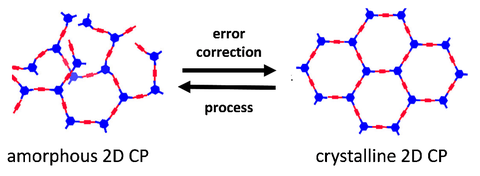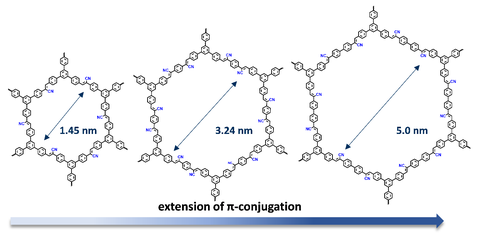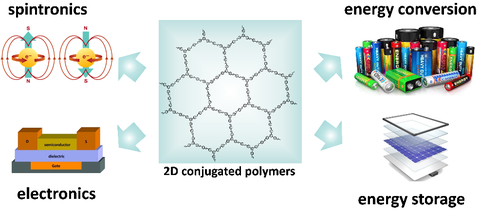2D Conjugated polymers
Following on the decades of investigation on the synthetic linear conjugated polymers with notable application potential in organic electronics such as organic field-effect transistors, organic solar cells and organic light-emitting diodes, two-dimensional conjugated polymers (2D CPs) have recently attracted growing research interest as a new generation of organic semiconducting materials. 2D CPs, as represented by graphene and 2D p-conjugated covalent-organic frameworks, are characterized by multi-strands of linear conjugated polymers with in-plane π-conjugation and regular 2D framework structures. The 2D CP subgroup of the Chair of Molecular Functional Materials is geared towards the synthesis of unprecedented 2D conjugated polymers with tailored opto-electronic properties by organic and polymer chemistry. We are focused to establish the rational synthetic methodologies for the solution synthesis of crystalline vinylene- and aryl-linked 2D CPs under controlled reaction conditions, among others. Furthermore, we aim to explore the unprecedented structure-property relationships of 2D CPs based on a variety of characterization methods. We also target at the implementation of these innovative materials into a variety of applications, such as organic electronics, spintronics, energy storage and conversion.
Reaction Methodology
Vinylene-linked 2D CPs have attracted increasing attention in terms of their intrinsic chemical stability and enhanced delocalized electronic structures. However, the synthesis of crystalline vinylene-linked 2D CPs remains challenging, because the C=C bond formation suffers from lower reversibility resulting in kinetically controlled amorphous porous polymers. The crystallinity of the obtained vinylene-linked 2D CP is not high yet, and the size of crystallites is limited to tens of nanometers. To achieve highly crystalline vinylene-linked 2D CPs, we like to gain deep understanding and controlling of the reaction kinetics to facilitate the reversibility, which is essential for achieving highly crystalline vinylene-linked 2D CPs. Other synthetic strategies for the novel 2D conjugated polymers including 2D polythiophene, 2D polypyrrole, etc, are also explored in our group.
Unprecedented 2D CPs
2D CPs have the advantage that the structures or topologies can be easily tailored by the implementation of different building blocks. In particular, the design of the monomers with different sizes, symmetries, substituents and reactive sites dramatically influence the structure and topology of 2D CPs. We are interested in the synthesis of unprecedented 2D CPs with attractive building blocks, topologies or functionalities.
Unique Properties of 2D CPs
Linear conjugated polymers have been well explored for electronic and optoelectronic devices. However, they provide a low charge carrier mobility due to the intermolecular hop of charges. To overcome these limitations, the extension of the π-conjugation into a second dimension provides a plausible solution to increase their mobility. For instance, graphene, which is a prototype 2D CP, demonstrates a high charge mobility of up to 200 0000 cm2V-1s-1. Although graphene has attractive electronic properties, it remains useless as a semiconducting material and thus for possible applications in digital electronics, because of the missing energy gap. In contrast, synthetic 2D CPs with a fully π-conjugated structure provide a well-defined energy-gap, which can be tailored by the organic synthesis. We are interested in the synthesis of highly conjugated 2D CPs with tailored redox- and/or (opto)electronic properties, which can be implemented into a variety of applications, such as electronics, optoelectronics, spintronics, energy storage, etc.



